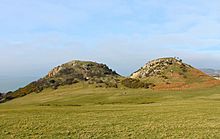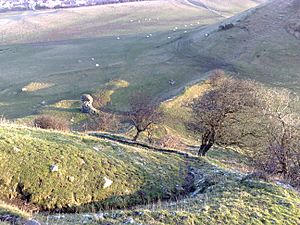Deganwy Castle facts for kids
Quick facts for kids Deganwy Castle |
|
|---|---|
| Conwy, North Wales | |

Deganwy Castle
|
|
| Coordinates | 53°17′51″N 3°49′44″W / 53.2975°N 3.8290°W |
| Type | Castle |
| Site information | |
| Condition | Earthworks remain |
| Site history | |
| Materials | Stone |
| Airfield information | |
| Elevation | 110 m (360 ft) AMSL |
Deganwy Castle (Medieval Latin: Arx Deganhui; Middle Welsh: Caer Ddegannwy; Modern Welsh: Castell Degannwy) was an early stronghold of Gwynedd and lies in Deganwy at the mouth of the River Conwy in Conwy, north Wales. It lies at an elevation of 110 m (361 ft) on a volcanic plug.
Details
The Early Middle Ages fortress, which is now little more than ditches and mounds, was made of wood and constructed on a massive rock outcrop in what is now the suburbs of modern day Llandudno. Traditionally, it was the headquarters of Maelgwn Gwynedd, King of Gwynedd (fl. c. 520–547). A nearby hill is called Bryn Maelgwyn and other places in the locality are associated with him. An important coin hoard of 204 Silver Cnut Pennies were found here in July 1979.
Deganwy was probably first occupied during the Roman period, but was popular in the years following their departure because it was safe from Irish raids. The area beneath the rocky stronghold may have been the site of a settlement of serfs. The stronghold was burned down in 812 when it was struck by lightning.
The castle was rebuilt in stone for King Henry III of England; the building work cost more than £2,200. The castle was destroyed by Llywelyn ap Gruffudd, Prince of Wales in 1263. Conwy Castle was later constructed just across the estuary.
When the ruins were excavated by archaeologist Leslie Alcock in the 1960s a dozen sherds of Dark Age pottery which had been imported from the Mediterranean were discovered indicating the far-reaching contacts of Gwynedd's royal dynasty.




